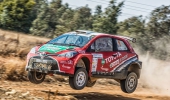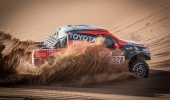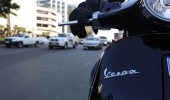Words & Photos: Francois Steyn - drivethis.wordpress.com
Whenever a couple of mates enter into a discussion about a new SUV built on a bakkie’s ladder frame chassis, the Toyota Fortuner always manages to creep into the conversation as the benchmark somehow. The new Chevrolet Trailblazer is no exception with its next generation Isuzu chassis. The Mitsubishi Pajero Sport is another example, with D-4D equalling power and torque, but lacks the variety in model range of its Japanese opponents.
The Trailblazer, however, has three engine variants, starting with the 2.5 LT Diesel (110 kW and 350 Nm), a powerful 2.8 LTZ Diesel (132 kW and an all-mighty 470 Nm) and a petrol burning 3.6 V6 (176 kW and 329 Nm). The 2.5 is only available with a 4x2 manual gearbox and the V6 with a 4x4 automatic. The LTZ 2.8 Diesel gives you any combination of drivetrain characteristics, except 4x2 manual, and is more powerful than the competition. The 2.8 LTZ 4x2 Automatic I tested is six grand less expensive than the matching Fortuner 3.0 D-4D Raised Body Auto, and has a towing capacity of 2,950 kg compared to the Toyota’s 1,825 kg.
Looks are in the eye of the beholder and in this subjective beholder’s eyes the Trailblazer is pretty much on par with its nemesis, sharing the Fortuner’s wrap-around rear window and blacked out B-pillar, but with an upright C-pillar to give it a beefier stance. There’s less bling on the ‘Blazer, but the black paint of the test model made it look more like a rapper’s ride than family fun wagon.
Looks are in the eye of the beholder and in this subjective beholder’s eyes the Trailblazer is pretty much on par with its nemesis, sharing the Fortuner’s wrap-around rear window and blacked out B-pillar, but with an upright C-pillar to give it a beefier stance. There’s less bling on the ‘Blazer, but the black paint of the test model made it look more like a rapper’s ride than family fun wagon.
Inside you’re treated to light coloured, full leather seats for up to seven adult occupants and a two-tone dash. Automatic air conditioning keeps the passengers cool in the rear with the push of a button on the disc-like switch console, on the centre hang down. Above the climate control command station is an integrated audio system featuring CD MP3, Bluetooth, USB and auxiliary inputs, with steering-mounted controls on the left side of the steering wheel. The right side houses the cruise control buttons.
In relaxed driving conditions I cannot fault the Trailblazer, and trying to overtake a slow moving vehicle is no problem thanks to maximum torque on tap from 2,000 r/min. The auto ‘box works fine, but eliminates a sense of control. In manual guise, the 2.8 Diesel would shine. Like the entry-level LT, the LTZ comes standard with ABS, EBD and BAS. Both models also have driver-, front passenger- and curtain airbags, as well as rear park assist and disc brakes all round. In addition to this, the LTZ boasts traction control, trailer sway assist and panic brake assist, and on the automatic model, hill descent control.
During my time with the Trailblazer I averaged 10litres per 100 km, which equates to a range of just over 750 km. The standard service plan matches Toyota’s five year / 90,000 km, but service intervals are 5,000 km further apart than the 10,000 km of the Fortuner. All said, the clear winner is ... Well, I’d hate to take a stab at it and in the end it will come down to personal preference.
Nissan Juke DIG-T Tekna (Leather)
Thankfully we’re done with comparisons because comparing the Nissan Juke to any other car would be like trying to compare a platypus to another mammal. I’m not insinuating that it’s ugly (you decide for yourself about the platypus), a Fiat Multipla is ugly, so is the Hyundai Matrix, but the frog-eyed Juke just does not look like anything else on the road.
Before I got a chance at the helm, I’d read and heard people raving about this awkwardly-styled cross over and wondered what it was all about. Press the start button and punch at the throttle though and it all makes sense. The 1.6 DIG-T Tekna’s turbocharged, four-cylinder petrol engine delivers 140 kW and 240 Nm, and will race from standstill to 100 km/h in under eight seconds, but you can still maintain 8 litres per 100 km. The steering and handling is good, but the high-riding position has the suspension’s work cut out in the corners to eliminate body roll. Under hard acceleration you better hold on to the wheel because there is quite a bit of torque steer as the front wheels try to track true. In all but the entry-level Acenta model there are three drive modes: Eco, Normal and Sport. In Sport the Juke jumps out of the blocks like a frisky Jack Russell, but the throttle response is so sensitive and revs already so high (just above 3,000 r/min) when you’re trying to maintain 120 km/h that you have to concentrate on not exceeding the speed limit.
The oddness of the design does not end on the outside, with the central multimedia and climate controls looking like they are trying to break free from the hard plastic facia. Below that, the six-speed gearbox’s lever sits atop a candy apple plastic shell, adding a toy-like vibe to the luxurious, heated leather seats that are standard in the Tekna model. The steering wheel, pilfered from the 370Z, houses the remote audio and cruise controls.
The Juke certainly is fun to drive and it's kitted out with a factory full of features, including a display for torque, G-force and all manner of interesting information on the display between the automatic air conditioner knobs. Safety features also litter the standard kit list, with plenty of airbags, ABS, EBD, BAS, Vehicle Dynamic Control (VDC) that can be switched off and automatic multi-reflector halogen headlamps, to name a few.
I am still not convinced about the appearance, but I personally know of more than a few happy owners who vehemently disagree. And I do get their point: most cars nowadays are so devoid of personality that we all long for something that turns heads again. Love it or hate it, it’s a brilliant (and refreshing) set of wheels.
Two New 800s from Kawasaki: W800 and Z800
In the beginning motorcycles were dirty, smoky, unreliable machines that offered one thing to those willing to live with it: freedom. Later they evolved into every imaginable niche: superbikes, adventure bikes, cruisers, scooters and streetfighters. These days though, there's a growing demand for brand new retro bikes styled on the machines of the '60s and '70s. That’s why KMSA has begun importing the Kawasaki W800, alongside the Moto Guzzi V7 and Triumph Bonneville offerings. It is recognisably a descendent of the Kawasaki W1 of 1967 that was in turn a licensed copy of the famous 500 cc BSA A7 that dated back to 1946. The modern bikes are completely different to the older BSAs and Kawasaki copies in every aspect except styling.
The W800’s 773 cc air-cooled, long-stroke engine uses fuel injection and a state-of-the-art electronic ignition system, so no kick starting this old bird. The designers took great pains to make the engine a thing of beauty and finished it in lustrous silver - either clear-coated, polished aluminium or chrome plating. The mudguards and side covers are made from steel rather than plastic, as they were in the '50s and '60s, and handsome, lightweight spoked wheels with aluminium rims that are dead right for the period. Traditional instrumentation and pea-shooter exhausts round off the old-school look. The soulful W800 is aimed at riders who enjoy an affordable, well-built modern classic that's built like an anvil. Included in the R109 995 price tag is a two year / unlimited distance warranty.
The new Kawasaki Z800 looks so wicked that it should come with horns and a tail included. The already lively engine's capacity was stretched from 748 to 806 cc for 2013, bumping peak power to 100 kW and torque to 83 Nm.
The handlebars are flatter, to give the bike more of a streetfighter appearance, while the handlebar risers are taller, to ensure the same riding position as before. There's a stylish rear hugger to keep the shock absorber and under-seat area clean, and a belly pan is now standard. The new instrument cluster has also been enhanced in that it displays remaining fuel range and boasts an economical riding indicator, while new rear-view mirrors improve awareness of what's going on behind you - not that something is going to catch up with you. The luggage hooks incorporated into the rear footrest hangers and mudguard make for easy loading when the bike is pressed into service as a tourer.
A whole range of changes were made to the air intakes, throttle bodies and intake and exhaust ports; the result being better tractability, lower weight and reduced engine wear. It also has larger diameter (310mm) petal discs up front, and a narrower 17-litre fuel tank and seat. Kawasaki has been making its famous Z bikes for four decades now and the new Z800 aims to remain a badass, street-fighting hooligan that can be ridden every day. It sells for R115 995 and also comes with a two year / unlimited distance warranty.











